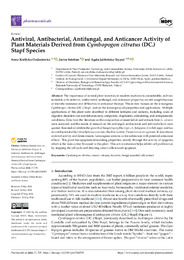Título :
Antiviral, Antibacterial, Antifungal, and Anticancer Activity of Plant Materials Derived from Cymbopogon citratus (DC.) Stapf Species |
Autor :
Kiełtyka-Dadasiewicz, Anna
Esteban Mozo, Javier
Jablonska-Trypuc, Agata |
Editor :
MDPI |
Departamento:
Departamentos de la UMH::Biología Aplicada |
Fecha de publicación:
2024-05-29 |
URI :
https://hdl.handle.net/11000/37576 |
Resumen :
The importance of natural plant materials in modern medicine is considerable, and raw
materials with antiviral, antibacterial, antifungal, and anticancer properties are still sought because
of microbe resistance and difficulties in anticancer therapy. This review focuses on the lemongrass
Cymbopogon citratus (DC.) Stapf. and on the lemongrass oil properties and applications. Multiple
applications of this plant were described in different latitudes and cultures, including cases of
digestive disorders and anti-inflammatory, antipyretic, diaphoretic, stimulating, and antispasmodic
conditions. Data from the literature on the composition of essential oil and extracts from C. citratus
were analyzed, and the results of research on the antifungal, antibacterial, and antiviral effects were
quoted. Essential oil inhibits the growth of fungi (Aspergillus niger, A. fumigatus, Candida spp.) and has
an antibacterial effect (Staphylococcus aureus, Bacillus subtilis, Pseudomonas aeruginosa). It also shows
antiviral activity and deters insects. Lemongrass contains active substances with potential anticancer
effects. This plant has apoptosis-stimulating properties, mainly through the activity of apigenin,
which is the main active flavonoid in this plant. This active substance helps inhibit cell proliferation
by stopping the cell cycle and directing cancer cells toward apoptosis.
|
Palabras clave/Materias:
Cymbopogon citratus
cancer
viruses
bacteria
fungi
essential oil
extract |
Área de conocimiento :
CDU: Ciencias puras y naturales: Biología |
Tipo de documento :
info:eu-repo/semantics/article |
Derechos de acceso:
info:eu-repo/semantics/openAccess
Attribution-NonCommercial-NoDerivatives 4.0 Internacional |
DOI :
https://doi.org/10.3390/ph17060705 |
Publicado en:
Pharmaceuticals, 2024, 17, 705 |
Aparece en las colecciones:
Artículos - Biología Aplicada
|
 La licencia se describe como: Atribución-NonComercial-NoDerivada 4.0 Internacional.
La licencia se describe como: Atribución-NonComercial-NoDerivada 4.0 Internacional.
.png)
